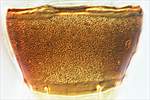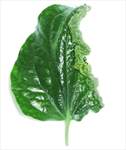
Liothrips female

vaneeckei

takahashii head

takahashii pronotum

umbratus pronotum

pallipes metanotum & pelta

takahashii metanotum & pelta

pallipes male pore plate

vaneeckei fore wing

vaneeckei prosternites

Liothrips gall on Piper sp. leaf
Generic diagnosis
Small to medium sized, dark, macropterous Phlaeothripinae with long dark setae. Head usually longer than wide, vertex transversely striate but reticulate on ocellar region; postocular setae long; mouth-cone long or short; maxillary stylets usually not retracted as far as postocular setae, and rarely close together. Antennae 8-segmented; segment III with one sense cone, IV with 3 (+1) sense cones; VIII slightly constricted at base. Pronotum transverse, with 5 pairs of long major setae; notopleural sutures complete. Prosternal basantra absent; ferna well developed; mesopresternum usually absent medially; metathoracic sternopleural sutures present but sometimes weak. Fore tarsal tooth absent in both sexes. Fore wings not constricted medially, with duplicated cilia. Pelta triangular; tergites II‒VII each with two pairs of sigmoid wing-retaining setae; tergite IX setae S1 and S2 usually long and pointed. Male tergite IX setae S2 shorter and stouter than S1; sternite VIII with pore plate.
Nomenclatural data
Liothrips Uzel, 1895: 261. Type species Phloeothrips setinodis Reuter 1880, designated by Hood, 1918.
There are rather more than 270 species listed in this genus (ThripsWiki, 2022).
Australian species
Liothrips brevifemur Girault, 1928: 2
Liothrips chavicae (Zimmermann, 1900: 14)
Liothrips pallipes (Karny, 1913: 110)
Liothrips soror (Hood, 1918: 138)
Liothrips takahashii (Moulton, 1928: 313)
Liothrips tenuis Hood, 1918: 133
Liothrips umbratus Hood, 1918: 132
Liothrips vaneeckei Priesner, 1920: 211
Relationship data
This is the largest genus in the Phlaeothripinae, but in Australia it is effectively replaced by the closely related genus Teuchothrips. In Australia there are many undescribed species in this group of genera, requiring extensive field work to establish host associations and the extent of within-species structural variation.
Distribution data
The genus is found worldwide, mainly in the tropics and with most named species from tropical Asia. Five of the eight species listed from Australia are from Queensland, but vaneeckei is reported around the world on lily bulbs.
Biological data
The members of this genus are all leaf-feeding, sometimes inducing rolled-leaf galls. However, L. vaneeckei is known as a minor pest of Lilium bulbs, and L. takahashii lives in leaf-galls induced by Gynaikothrips species on Ficus species where it is probably an inquiline rather than a predator.
References
Mound LA (2008) Identification and host associations of some Thysanoptera Phlaeothripinae described from Australia pre-1930. Zootaxa 1714: 41–60.
Mound LA (2020) Liothrips species (Thysanoptera, Phlaeothripinae) from leaf-galls on Piper species in Southeast Asia and Australia. Zootaxa 4830 (2): 383–391.
ThripsWiki (2022) ThripsWiki - providing information on the World's thrips. Available from: http://thrips.info/wiki/ (Accessed 15.iii.2022)